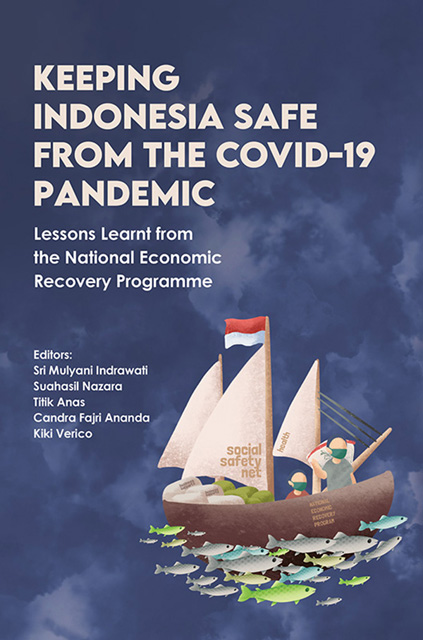 Keeping Indonesia Safe from the COVID-19 Pandemic
Keeping Indonesia Safe from the COVID-19 Pandemic Book contents
- Frontmatter
- Contents
- List of Figures
- List of Tables
- List of Boxes, Annexes and Appendixes
- Acknowledgements
- Glossary
- The Contributors
- Foreword: Keeping Indonesia Safe from the COVID-19 Pandemic Lessons Learnt from the National Economic Recovery Programme
- Part I Health Shock
- Part II Economic Shock: The Framework
- Part III Revenue Shock And Response
- Part IV Expenditure Side (Human Capital)
- Part V Expenditure Side (Msmes And Corporate Sector)
- Part VI Regional Dynamics
- Part VII New Ways Of Working
- Index
10 - Mental Health during the COVID-19 Pandemic: An Issue Less Visited
Published online by Cambridge University Press: 30 June 2023
- Frontmatter
- Contents
- List of Figures
- List of Tables
- List of Boxes, Annexes and Appendixes
- Acknowledgements
- Glossary
- The Contributors
- Foreword: Keeping Indonesia Safe from the COVID-19 Pandemic Lessons Learnt from the National Economic Recovery Programme
- Part I Health Shock
- Part II Economic Shock: The Framework
- Part III Revenue Shock And Response
- Part IV Expenditure Side (Human Capital)
- Part V Expenditure Side (Msmes And Corporate Sector)
- Part VI Regional Dynamics
- Part VII New Ways Of Working
- Index
Summary
THE CURRENT TREND OF MENTAL ILLNESS
Global Trend
Globally, mental illness has been recognized as a less addressed disease while having a large economic impact (Chong et al. 2016; Steel et al. 2014; United Nations, Department of Economic and Social Affairs 2022). It is estimated that globally, in 2010, the productivity loss due to anxiety and depression amounted to US$1 trillion per year, while mental health in general resulted in losses as high as US$2.5 trillion per year due to poor health and productivity losses, and that number is projected to increase to US$6 trillion by 2030 (Lancet Global Health 2020).
As a type of mental illness, depressive disorders were among the leading causes of years lived in disability (YLD) counts in 2017, and mental disorders, in general, shared more than 14 per cent of age-standardized YLDs during the last thirty years. The prevalence of mental disorders is higher than 10 per cent in all twenty-one Global Burden of Disease (GBD) regions (e.g., Southeast Asia, East Asia, and Oceania) (James et al. 2018; Moran et al. 2012).
Looking at figures taken from the Institute for Health Metrics and Evaluation (IHME) website (Institute for Health Metrics and Evaluation 2019), mental disorders have increased in rank in terms of Disability Adjusted Life Years (DALYs) from number 13 in 1990 to number 7 in 2019 (Figure 10.1), potentially showing a substantial increase in severity and the number of diseases. However, in terms of Years Lived in Disability (YLD), mental disorders consistently sat at the 2nd rank in both 1990 and 2019, showing a potentially similar trend over the 29 years (Figure 10.2).
As an example of the burden of mental illness, studies have shown that psychotic disorders are associated with both health and nonhealthcare costs. However, it is less known that the non-healthcare costs component such as productivity loss (Knapp and Wong 2020) has a large share (more than 50 per cent of the total cost). Such a trend is shown by various studies in different countries such as China, Australia, Japan, England, Ireland, Spain, Belgium, Korea, the United States of America and Canada (Sado et al. 2013; Mangalore and Knapp 2007; Phanthunane et al. 2012; Charrier, Chevreul, and Durand-Zaleski 2013; SANE Australia 2002; Fasseeh et al. 2018; Zhai et al. 2013).
- Type
- Chapter
- Information
- Keeping Indonesia Safe from the COVID-19 PandemicLessons Learnt from the National Economic Recovery Programme, pp. 318 - 351Publisher: ISEAS–Yusof Ishak InstitutePrint publication year: 2022


